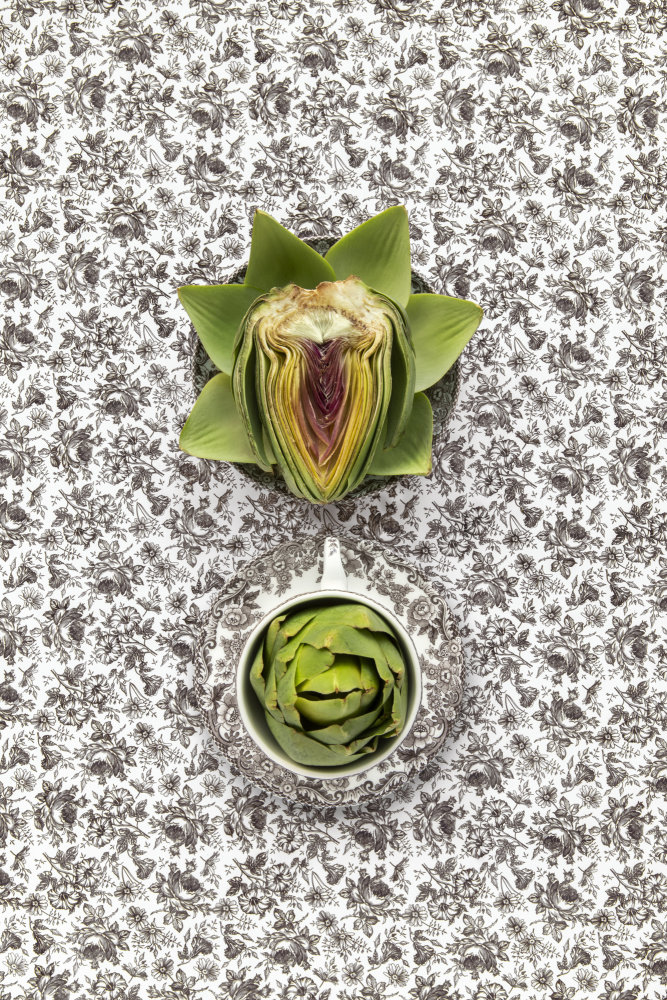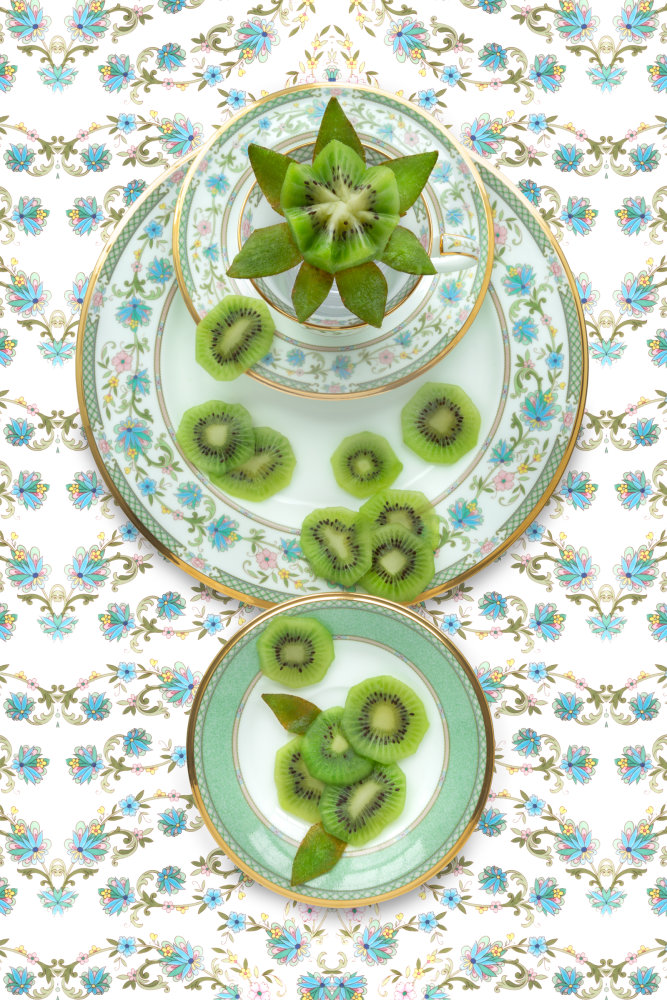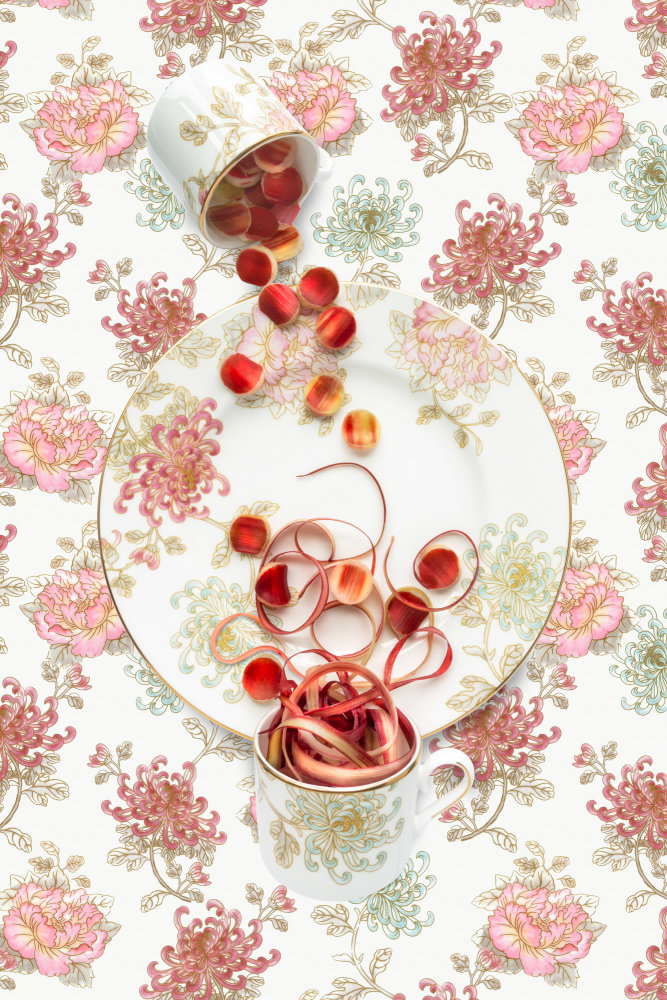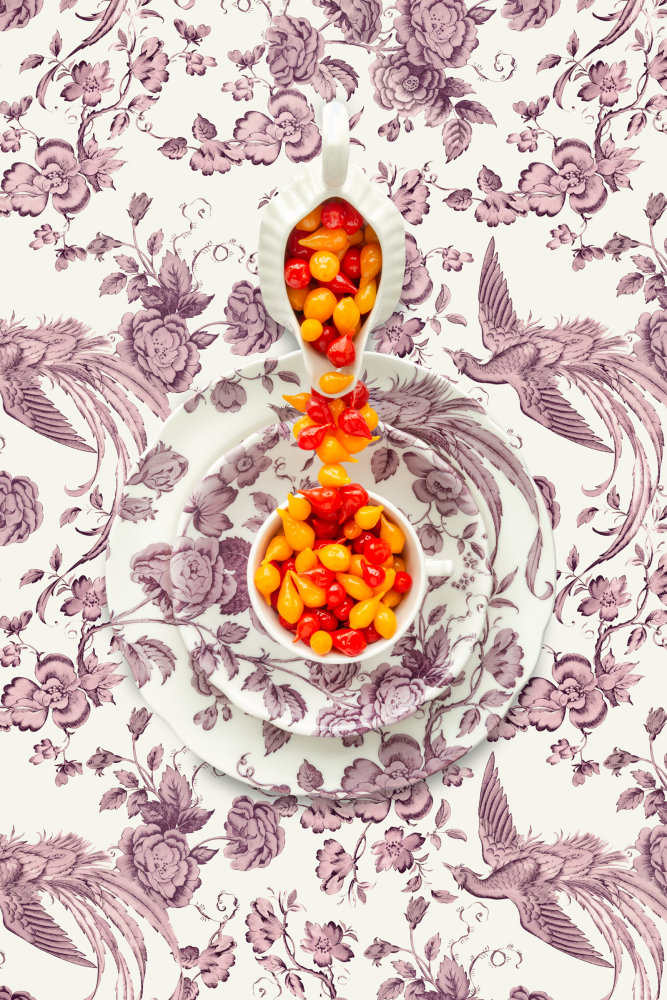
“The Good Dishes” by JP Terlizzi is photography-based artwork with a foundation in family tradition, history and culture. He broadens a classic still-life genre into a series of images that celebrate life and memory. “The Good Dishes integrates memory, legacy, and metaphor with my response to loss. As I witness an early generation of family members pass, my cousins and I were each tasked with the emotional challenge of cleaning out the family home. Sorting through the heirlooms, we would determine which items to toss, sell, or preserve. Without fail, when it came to the family’s fine china, that item was always given to the person that most cherished its memory and sentimental value.”

© JP Terlizzi, Spode Delamere with Artichoke (2019)
When did still life imagery as art become prevalent? The Encyclopedia Britannica describes the “Still-Life” genre in art: “Still-life painting, depiction of inanimate objects for the sake of their qualities of form, colour, texture, and composition. … Early Netherlandish still-life paintings depicted skulls, candles, and hourglasses as allegories of mortality, or combined flowers and fruits of all seasons to symbolize nature’s cycle… An interest in observing and then realistically representing the material details of the environment, the rise of a wealthy middle class who desired art works to decorate their homes, and an increasing demand for secular subjects in painting other than portraiture as a result of the prolonged effects of the Reformation—all were factors that contributed to the rise of still-life painting in the 16th and 17th centuries. … The “golden age” of still-life painting occurred in the Lowlands during the 17th century.”
How and when did still-life images begin to appear in photography? A still life, as the term originated, referenced dead objects, “nature morte.” In the history of photography, the still life style may not have started out that way. One of the earliest photographs (a heliograph), known as “The Set Table,” was a still life of dishes, glass, and bottles on a table taken circa 1827 by Nicephore Niepce as described in the introductory text by Paul Martineau for his text on “Still Life in Photography.” In the introductory essay to this J. Paul Getty exhibition book, Martineau comments that Henry Fox Talbot, an early British inventor of photographic processes (in particular the Calotype paper negative/positive process), created still life images. He also notes that early photographers in the 1800s, wishing to have their work considered “art,” and not just mechanical reproductions of nature, included traditional iconography into their images of dead animals, plants, and inanimate objects. Terlizzi’s works are alive, however, and not “nature morte.”
Another British photographer from the mid-1800s, Roger Fenton, expanded on what Talbot had started with still life photography. Pam Roberts, an independent researcher, curator, and writer, penned the essay “Roger Fenton and the Still-Life Tradition” included in “All the Mighty World: The Photographs of Roger Fenton, 1852-1860” by Gordon Baldwin, Malcolm Daniel and Sarah Greenough. Fenton created a number of still lifes that included fruit, flowers, and patterned textiles along with other objects. Roberts suggests that Fenton, as involved as he was in the arts of Britain during this period, was very influenced by still life painters of that day such as George Lance and Edward Ladell. In her essay, Roberts explains how Fenton uniquely moved the photographic use of still life works forward as an artistic exercise influenced by and wishing to aspire to the same respect painting had during that time.

© JP Terlizzi, Royal Albert Gratitude with Cherry (2019)
It is established, yet long debated, that photography can produce images which are considered “art.” Many consider art to be all about the image; whether painted, sculpted, woven, or printed. Art is not defined by how it is made, although the tools and methods used may influence whether the work created, in this case a two-dimensional image, is still a photography-based work. The still life genre, however, as Martineau notes, ebbed and flowed over the years, influenced by changing tastes and technology. Some great works in the still life genre that may have influenced Terlizzi’s practice are Edward Weston’s pepper and Irving Penn’s frozen vegetables and cigarettes.
Today, JP Terlizzi and another photographer, Adrian Fernandez, both close in age but worlds apart, have reinterpreted the “still life” in a similar visual manner. The floral works of Cuban photographer Adrian Fernandez, in his series “To Be or to Pretend” (https://adrianfernandezphotography.com/category/works/to-be-or-to-pretend/ ), have a traditional “straight-on” view of the staged image. Terlizzi offers a different visual perspective. The straight-on view is the most commonly used in still life images, both in painting and photography, positioned as if standing and looking straight on to a table top of objects all purposely and neatly arranged. Conversely, with Terlizzi, the perspective is always from directly above the table top looking down. We do not see a table top. What we see is an arrangement of fine china with a selection of only one type of fruit or vegetable, dissected and laid out in varied patterns spilled across the image. Yet, like Terlizzi, Fernandez uses a singular plant and vase arrangement against a patterned background. Each image in this series is uniquely different in style, texture and color, as with Terlizzi. Fernandez’s motivation is very different, however—his imagery is motivated by the history, politics, class, and wealth issues that are unique to Cuba. Terlizzi tells a story of how a type of physical object passes from generation to generation as memory and as a linkage to a common heritage. Fernandez uses existing physical backgrounds that are visually different from either the flowers or vase in the image. Terlizzi fabricates a background that echoes the patterns in the fine china pattern.

© JP Terlizzi, Wedgwood Hibiscus with Red Onion (2019)
The firm Scully and Scully provides a brief history of fine china. (https://www.scullyandscully.com/blog/whats-the-difference-between-fine-china-dinnerware/) “Although it isn’t capitalized, the origins of this word do indeed derive from the country China. Fine china was first produced during the Tang dynasty (618-907). The early 8th century of this dynasty was a golden age in which beautiful art and culture flourished. Fine china is made from kaolin, a type of white clay. Porcelain is also made from kaolin, but the firing temperature is higher than that of fine china, making it more durable.
The word porcelain derives from the Latin word porcella, which means seashell. Both fine china and porcelain are smooth, white, and lustrous in their glazed form. When porcelain is unglazed, it is known as bisque or biscuit, but that form isn’t used in tableware because it’s too porous. When people use the word china in America, it is often used more generically, referring to high-quality dishes used for special occasions, rather than every day, more casual tableware. …The English company Spode was the first company to manufacture bone china in 1790, using human bone ash. Today, bone china is made from feldspar, ball clay, quartz, and kaolin with cow bone that has been finely ground into a powder or ash…”
As a child, Terlizzi recognized how precious fine china was considered in the past. The manner and use of the fine china in the Terlizzi home demonstrated how the fine china was used as a tool for expression and communication to guests. “Along with my mother’s everyday dishes she had one set that she kept on display behind glass that only she handled, only she washed, and only she hand-dried; these were deemed “the good dishes.” Whenever I heard, “I need to use the good dishes,” that meant one of two things in our household: the priest was coming over for dinner or it was a very special occasion.”

© JP Terlizzi, Noritake Yoshino with Kiwi (2020)
Terlizzi is somewhat working against today’s tastes as people are losing interest in using fine china. In the past, there was a tradition of pulling out special (and expensive) plates for special quests or special occasions and holidays. However, tastes have changed. Standards for entertaining have changed. Tastes in design and patterns have changed from the complex to the simple, even a basic white plate can be elegant when presented in a minimalist setting. It is no longer a rite of passage to acquire beautiful sets of dishes. Elaborate and elegant entertaining was a sign of status and taste. At the same time, some might argue that fine china will make a comeback as people look for ways to “dress-up” their cooking and entertainment again in a post-Covid future. Maybe things are cyclical—maximalism is already beginning to have a resurgence.
Terlizzi’s choice to create a body of work around fine china is fascinating not only in its photographic history but also because of the rich story behind the subject. What makes fine china special, and how did that motivate Terlizzi to photograph it? How did he come to the process of replicating the patterns on the dishes as backgrounds for the china itself? The original patterns may have been hand painted, depending on the producer. Terlizzi replicates the China pattern using technology to create a wallpapered back ground of the pattern in the plates. Then he adds his own touch. In selecting and artfully laying out a fruit or vegetable with the plate, and using technology to produce a wallpaper-like background echoing the pattern in the fine china, he is creating something new and unique.
Consider what these fruits and vegetables, artfully incorporated into the still life compositions, represent. Today we take great interest in what we eat. Terlizzi’s choice of food is fruits and vegetables. These are all healthy foods! Terlizzi does not any “junk food.” In fact, in many cases the food is exotic, colorful, no doubt flavorful, and, in some cases, expensive. His choice of food in some cases conveys a special appreciation for a guest as much as using fine china. In the current “Good Dishes” collection there are 25 different patterns matched to 25 different fruits and vegetables. In Terlizzi’s images we see fruits like oranges, blueberries, pomegranates, apples, grapes, melons, strawberries, grapefruits, lemons, currants, cherries, limes, and plums. When it comes to vegetables, we see cabbages, artichokes, red onions, spring onions, peppers, broccolini, radicchio, beans, watermelon radishes, and traditional radishes. Terlizzi carefully matches the fruit or vegetable to the plate, and the plate to its carefully crafted background.

© JP Terlizzi, Marchesa Camellia with Rhubarb (2020)
Each of patterns selected by Terlizzi, from florals to birds to fashion, has an intricate history. The Spode Delamere pattern of British flowers, from Terlizzi’s research, dates back to 1831. Spode is a UK company that has created beautiful earthenware, porcelain, and china since the 1780s. The Royal Albert company, its patterns now apparently owned by Wedgwood, was founded in the 1890s. From their web site, the patterns used were “inspired by the English country garden and the national flower, the rose.” The word “Kingsley” in the Spode Kingsley with birds in flight was an apparent reference to the king’s wood or meadow. (Terlizzi can be seen working on his “Spode Kingsley with Biquinho Peppers” image in this short video). Fine china, despite its name, came to be widely made in other countries. Noritake grew out of a trading company that operated in Japan and New York. It’s Yoshino pattern, according to their history, is a floral of the “harmony of east and west influences.” Wedgwood, established in 1759, finds its “Wild Strawberry” pattern apparently inspired by the English tradition of strawberries and cream. According to the Terlizzi, the Marchesa Camellia pattern from Lenox derives from the fashion house of Marchesa.
In a COVID-19 pandemic-threatened world of imposed isolation and limited small gatherings, perhaps entertaining will once again become a center point of focus in our lives when we and our guests, in the future, are spending more time together. In the past, there was once a focus on collecting a complete set of a specific pattern of dishes. Like Terlizzi’s elegant mix of varied plates, may be the use of fine china will be re-born in a trend with a preference toward mixing and matching. In a post-COVID world, and a hopeful future re-emergence of interest in socializing with friends and family again, dining will again take on a special importance. Looking at all of Terlizzi’s different images of patterns with fruits and vegetables gives us freedom for inspiration. We are surrounded by an artistic invitation to appreciate the beauty of an object assessable to all that we may have overlooked. We have a chance to begin new traditions, and memories, redefined.

© JP Terlizzi, Spode Kingsley with Biquinho Peppers (2020)
